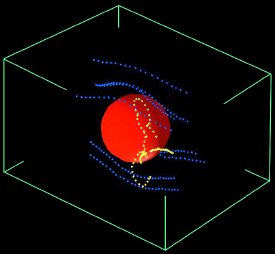Counting and tracking particle movement in 3D is one of today’s biggest imaging challenges. Using powerful 3D analysis and holographic imaging technology, Resolution Optics’ new DIHM series has successfully tackled these challenges, providing accurate, high-speed, in-situ volume analysis at sub-micron level resolution, in configurations that work on the lab bench or in the deep sea.
 Tracking micro-flow in 3D is critical for microfluidics and flow processes. Bacterial movement, flowing from left to right around a large metallic bead (~ 100 um diameter). Image Credit: Resolve Optics
Tracking micro-flow in 3D is critical for microfluidics and flow processes. Bacterial movement, flowing from left to right around a large metallic bead (~ 100 um diameter). Image Credit: Resolve Optics
DIHM is powered by HoloSuite, proprietary image acquisition and processing software. HoloSuite operates in conjunction with the DIHM unit, which consists of a point source, custom staging, and CCD camera. With this integrated solution, HoloSuite is able to collect a 2D hologram which contains all of the information about the three-dimensional structure of the object. A set of holograms, taken ove time, can be summed to provide information about movement and patterns within the sample.
Applications for DIHM range from identifying and counting particles surging through microfluidic devices or the movement of live cells in-situ to tracking bubble formation, nucleation events, and particle coagulation.
When asked about the secret to their success, Dr. Juergen Kreuzer, Co-founder and scientific advisor responded, “We’ve been able to leverage our proprietary algorithm with modern technology, in particular the CCD chip and fast processors. This synergism has enabled us to achieve Gabor's dream of remotely imaging the motion of particulates and biological species such as algae in situ with micron and subsecond resolution even in the depths of the oceans or hostile environments such as the Arctic. The applications of this new technology to monitor water quality and pollution, pharmaceutical process, conventional biological or materials studies are limitless.”
The Digital In-line Hologram Microscopy (DIHM) series takes microscopy from the bench top to the deep ocean. D-DIHM, the flagship of the line, has the look and feel of a conventional microscope but can be used interchangeably between upright and lateral position allowing for both horizontal and vertical specimen observation. Alternatively, the A-DIHM (a special objective and point source) can be used with HoloSuite to convert conventional microscopes for the same purpose.
S-DIHM is a uniquely designed submersible system which can operate to a depth of 5 km [3 miles] enabling in-situ study of fresh water and marine organisms such as monitoring the colonization of surfaces by bacteria. Each DIHM allows experiments to be executed and processed with incredible time efficiency, in addition to ensuring that observed organisms or delicate particles remain unharmed.
Current clients for the DIHM include the Canadian Space Administration as well as a number of universities in Canada and Europe.